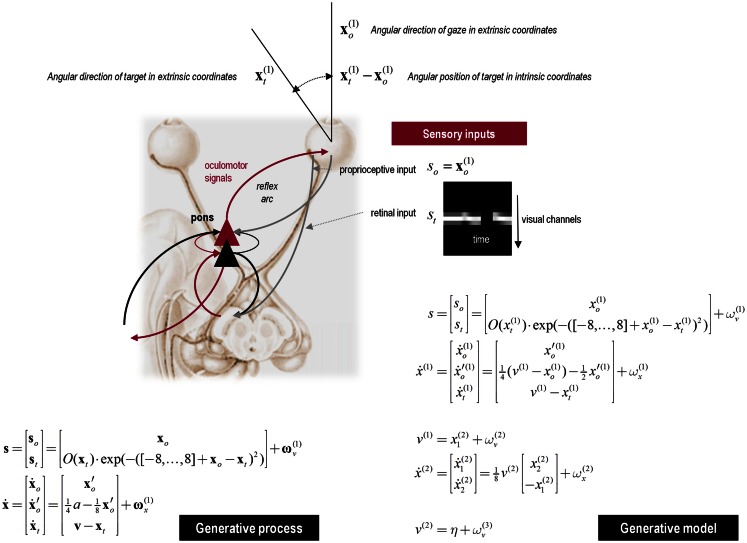Figure 6.
Upper panel: this schematic summarizes the generative model for smooth pursuit eye movements. The model is based upon the prior belief that the center of gaze and target are attracted to a common (fictive) attracting point in visual space. The process generating sensory inputs is much simpler and is summarized by the equations specifying the generative process (lower left). The real-world provides sensory input in two modalities: proprioceptive input from cranial nerve nuclei reports the (horizontal) angular displacement of the eye so and corresponds to the center of gaze in extrinsic coordinates xo. Exteroceptive (retinal) input reports the angular position of a target in a retinal (intrinsic) frame of reference st. This input models the response of 17 visual channels, each equipped with a Gaussian receptive field deployed at intervals of one angular unit – about 2° of visual angle. This input can be occluded by a function of target location O(xt), which returns values between zero and one, such that whenever the target location xt is behind the occluder retinal input is zero. The response of each visual channel depends upon the distance of the target from the center of gaze. This is just the difference between the oculomotor angle and target location. The hidden states of this model comprise the oculomotor states – oculomotor angle and velocity and the target location. Oculomotor velocity is driven by action and decays to zero with a time constant of eight time bins or 8 × 16 = 128 ms. This means the action applies forces to the oculomotor plant, which responds with a degree of viscosity. The target location is perturbed by the hidden cause v that describes the location to which the target is drawn (a sinusoid), with a time constant of one time bin or 16 ms. The random fluctuations on sensory input and the motion of hidden states had a log precision of 16. The generative model (lower right) has a similar form to the generative process but with two important exceptions: there is no action and the motion of the hidden oculomotor states is driven by the same hidden cause that moves the target. In other words, the agent believes that its gaze is attracted to the same fictive point in visual space that is attracting the target. Second, the generative model is equipped with a deeper (hierarchical) structure that can represent periodic trajectories in the hidden cause of target motion: hidden causes are informed by the dynamics of hidden states at a second level . These model sinusoidal fluctuations of any amplitude and a frequency – that is determined by a second level hidden cause v(2) with a prior expectation of η. This prior expectation corresponds to beliefs about the frequency of periodic motion. The log precisions on the random fluctuations in the generative model were three at the first (sensory) level and minus one at the higher level, unless stated otherwise.

